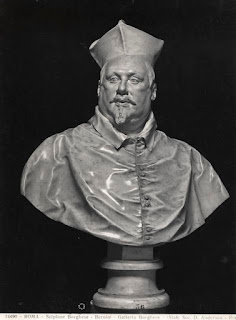Explication
On stage a man gone in and looked public, very numerous, and he begun
so: “Good evening and welcome for to listen me and history of art, in this
evening I will explain Gian Lorenzo Bernini, Italian sculptor of 17th
century and always called Baroque; the first work of Bernini we today don’t
know what is, a lot of hypothesis are presented but not very convincing, we can
begin with some his work: for example l’Apollo
and Daphne(Figg.1-2), material of marble was bought the 2 August 1622 and
shows the transformation of Daphne to bay, but Bernini no shows past or future
but during, this transformation is actual, in this moment Ovid writes his
Metamorphoses, and now Daphne become lay, this is the Baroque, this is show in
sculpture, which differently to show this rest for ever, Daphne become a lay;
but who is Daphne? She is a nymph, following of Diana and wont married, but
Eros for a revenge against Apollo he shoots an arrow and provokes love in
Apollo who follows Daphne and she asks transformation in lay for ovoid this
meet with Apollo, Ovid talks this episode; but other symbolism is present; Daphne
is easily assimilated to purity, therefore the virtue that escapes every
impudence. In fact, Maffeo Barberini, an Italian cardinal, had imagined these
verses “Everybody lovers follows the
beauty form, his hands will full alone with leafy branch”; this sculpture
was episode warning that Borghese used for to document how man is always
forward thing that are very little and that is important now tomorrow will be nothing,
it is moral warning. “But” lecturer continued “in this Baroque where all is
theater is also one moment for real impression; the natural plant of lay, and
the realism of expression are a gift that Bernini gives to realism; therefore,
when you will see this sculpture you will think that it is moment for think and
a moment for astonish, that now happen, Bernini has makes topical the past.
Thank and I hope that you don’t boring much.” Dark in the room and other image
shows, lecture therefore follows: “This is portrait of Cardinal Borghese(Figg.3-4),
very natural posture and of this portrait are in same Museum, two version,
because Bernini had trouble of break and therefore must rework a new portrait for
15 days, also for this portrait Bernini uses same concept that had used for
Apollo e Daphne, realism and naturalism, Bernini in fact portraited his
costumer before that he begun work for natural behavior and after worked their portrait,
with Scipione is same process, and Bernini leaves that we see Scipione Borghese
with his natural posture.”
Alessandro Lusana
Esplicazione
Sulla scena un uomo entrò
e guardò il pubblico, davvero numeroso, e cominciò: “Buona sera e benvenuti per
ascoltare sia me che la storia dell’arte; questa sera parleremo di Gian Lorenzo
Bernini, scultore italiano del XVII secolo e sempre definito Barocco, la prima
opera di Bernini noi oggi non la conosciamo, molte ipotesi sono state avanzate
ma davvero poche sono convincenti, noi però possiamo cominciare con qualche sua
opera: ad esempio l’Apollo e Dafne(Fig.1), il materiale per la scultura fu
acquistato il 2 agosto 1622e mostra la trasformazione di Dafne in alloro,
Bernini non rappresenta il passato ovvero il futuro ma il durante, questa
trasformazione è attuale, in questo momento Ovidio scrive le sue Metamorfosi, e
ora Dafne diviene lauro, questo è il Barocco manifesto nella scultura, che
resta per sempre; ma chi è Dafne? Una ninfa, seguace di Diana che rifiuta il
matrimonio, ma Eros per una vendetta
contro Apollo scocca la freccia e provoca l’amore in Apollo, che segue
Dafne e lei chiede di trasformarsi in
alloro per sfuggire le voluttuose volontà di Apollo; altri simbolismi sono
presenti, Dafne resta facilmente assimilabile alla purezza, quindi la virtù che
rifugge qualsiasi impudicizia. Infatti Maffeo Barberini, un cardinale scrisse
questi versi per la statua: “Ogni amante che insegue la bella forma colmerà la
sue mani con le sole fronde”, questa scultura era un episodio monitore che il
Borghese usò per documentare che l’uomo è sempre proiettato verso cose che
hanno un valore molto relativo. “Ma” continuò il lettore “in questo Barocco
dove tutto è teatro un momento è dedicato alla reale impressione; la pianta
naturale di alloro, e il realismo delle espressioni sono un dono che Bernini
compie al realismo; quindi quando vedrete questa scultura penserete che questo
è un momento sia per pensare che per sorprendervi, e che ora accade, Bernini
attualizza il passato millenario”. Buio in sala ed un’altra immagine segue: “Questo
è il ritratto di Cardinal Scipione Borghese(Figg.3-4), davvero naturale postura
e di questo ritratto ci sono due versioni nello stesso Museo, perché Bernini
ebbe il problema di una frattura e quindi dovette eseguire nuovamente il
ritratto intero, che rifece in 15 giorni, anche per questo ritratto Bernini
usò lo stesso concetto che impiegò per l’Apollo
e Dafne, realismo e naturalismo, Bernini infatti ritraeva i suoi committenti
prima che il ritratto effettivo
cominciasse, li guardava e studiava nei loro atteggiamenti naturali, e quindi
Bernini ci concede di guardare Scipione nella sua naturale postura.”
Alessandro Lusana
Fig.1
Fig.2
Fig.3
Fig.4







No comments:
Post a Comment